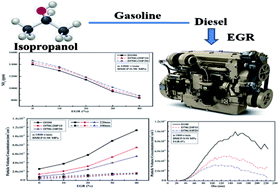Experimental investigation on NOx and PM pollutions of a common-rail diesel engine fueled with diesel/gasoline/isopropanol blends
Abstract
Gasoline and isopropanol are mixed with diesel to form stable, transparent and homogeneous blend fuels, to augment the air inhalation with high volatility and to increase the fuel oxygen. Nitrogen oxide (NOx) and particulate matter (PM) pollutions of diesel, gasoline and isopropanol blends were experimentally studied on a 4-cylinder common-rail diesel engine. The test fuels were marked as D100 (diesel), D70G20P10 (20% gasoline, 10% isopropanol and 70% diesel, by vol) and D70G10P20 (10% gasoline, 20% isopropanol and 70% diesel, by vol). Blend fuels have longer ignition delays (IDs), less combustion durations and hotter peak combustion temperatures (PCTs) than diesel, which are very important reasons for the reduction of PM and increment of NOx. The test results of PM number and volume concentrations and NOx pollutions have supported it. Moreover, an interesting result is found: isopropanol has a better effect than gasoline in reducing PM pollutions and increasing NOx pollutions. Exhaust gas recirculation (EGR) has been applied to decrease the NOx pollutions. NOx and UFP emissions are simultaneously reduced by isopropanol at a suitable EGR ratio, and D70G10P20 is a potential applicable fuel for low-pollution diesel engines with EGR.



 Please wait while we load your content...
Please wait while we load your content...